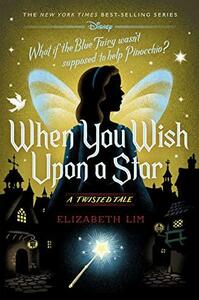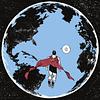Take a photo of a barcode or cover
adventurous
hopeful
inspiring
medium-paced
Plot or Character Driven:
A mix
Strong character development:
Complicated
Loveable characters:
Complicated
Diverse cast of characters:
No
Flaws of characters a main focus:
Yes
This book was engaging, with fun original characters added to a Disney classic. It had a lot of original elements to it.
I felt the creepy tone of Pinocchio could have been better expressed by the author, because whenever it was there it felt kind of shoehorned into a family drama. The town which was our main setting was inconsistent- was it a lovely town where everyone knew each other and young people could freely walk, or was it a dangerous port town and the parents were just grossly negligent?
Over all, my complaints are minor. The ending was a little anti-climactic, but otherwise I had a great time. Definitely better than the Hercules twisted-tale. It could have stood alone as a children’s book without the Disney label, which is pretty darn good.
I felt the creepy tone of Pinocchio could have been better expressed by the author, because whenever it was there it felt kind of shoehorned into a family drama. The town which was our main setting was inconsistent- was it a lovely town where everyone knew each other and young people could freely walk, or was it a dangerous port town and the parents were just grossly negligent?
Over all, my complaints are minor. The ending was a little anti-climactic, but otherwise I had a great time. Definitely better than the Hercules twisted-tale. It could have stood alone as a children’s book without the Disney label, which is pretty darn good.
adventurous
emotional
hopeful
mysterious
fast-paced
Plot or Character Driven:
Character
Strong character development:
Yes
Loveable characters:
Yes
Diverse cast of characters:
Yes
Flaws of characters a main focus:
Yes
medium-paced
It was more enjoyable than I had anticipated. I much prefer the Disney Princess and was looking forward to their books because of the romance and action. However, I have never even had the inclination to watch Pinocchio. I was thinking this story was going to be like Unbirthday by Liz Braswell in the series that I absolutely hated. So I kept putting off this book, however I was decently surprised. I was not amazed by this story but I was thoroughly entertained for the most part. I loved Ilaria's and Chiara's sisterly relationship, and Ilarias's fling with Ghepetto. It's not the worst in the series but there are better. It was a nice cute story overall.
lighthearted
relaxing
medium-paced
Plot or Character Driven:
Plot
Strong character development:
Yes
Loveable characters:
Yes
Diverse cast of characters:
Yes
Flaws of characters a main focus:
Yes
hopeful
inspiring
medium-paced
hopeful
inspiring
medium-paced
I always loved the Blue Fairy from Pinocchio, so I was excited to read this book. But sweet Lord it was so boring. I didn't like any of the characters, nothing really happens, the end is predictable, just...blah.
I'm not totally sure what to say about this book. I really liked it—I did. I loved the direction that Elizabeth Lim took the story of Pinocchio, but something is nagging at me, something that is preventing me from putting this at five stars.
Most of the book takes place forty years before Pinocchio, showing how the Blue Fairy became the Blue Fairy. I actually really like how the world of the Wishing Star was built—how all the fairies were associated with colors and had their own houses and actually lived on the Wishing Star. I also liked the process of Ilaria becoming a Heartless, and how the fairies interacted with the humans. One of my favorite elements of the flashback was Gepetto and Ilaria's relationship; how they went from friends to maybe more than that. I really was rooting for them the whole time. Honestly, I was also rooting for Ilaria, even though I knew she was going to turn bad. Chiara and Ilaria's relationship as sisters was also very well done; that was another element I loved. I also appreciated how the author incorporated Monstro, the inspirations for Cleo and Figaro, and how the boys turned into donkeys on Pleasure Island into the flashback section.
Lim also wove Chiara and Ilaira's relationship into the story of Pinocchio really nicely, and I loved how the element of a bargain was added into the story. It made the stakes feel that much higher. However, I did feel like some parts of the book—not all in the "movie" section, it happened in the "flashback" section too—seemed rushed, or there seemed to be a lot of telling instead of showing. There were a few scenes that I felt could have been stretched out more—for instance, the scene where the good fairies put Monstro to sleep for the first time. This is the problem with being an aspiring author—my brain is silently breaking apart all these writing techniques and doing analysis on an author's writing style, which sometimes takes away from my enjoyment of a book.
Ultimately, all I can say for certain is that I definitely liked Lim's other Twisted Tales better. This one is definitely a great addition to the series, but for various—probably small—reasons, it's not up to five stars for me. Hopefully that will change the next time I read this, and I can't wait for the Twisted Tales anthology that's coming in October!!
Most of the book takes place forty years before Pinocchio, showing how the Blue Fairy became the Blue Fairy. I actually really like how the world of the Wishing Star was built—how all the fairies were associated with colors and had their own houses and actually lived on the Wishing Star. I also liked the process of Ilaria becoming a Heartless, and how the fairies interacted with the humans. One of my favorite elements of the flashback was Gepetto and Ilaria's relationship; how they went from friends to maybe more than that. I really was rooting for them the whole time. Honestly, I was also rooting for Ilaria, even though I knew she was going to turn bad. Chiara and Ilaria's relationship as sisters was also very well done; that was another element I loved. I also appreciated how the author incorporated Monstro, the inspirations for Cleo and Figaro, and how the boys turned into donkeys on Pleasure Island into the flashback section.
Lim also wove Chiara and Ilaira's relationship into the story of Pinocchio really nicely, and I loved how the element of a bargain was added into the story. It made the stakes feel that much higher. However, I did feel like some parts of the book—not all in the "movie" section, it happened in the "flashback" section too—seemed rushed, or there seemed to be a lot of telling instead of showing. There were a few scenes that I felt could have been stretched out more—for instance, the scene where the good fairies put Monstro to sleep for the first time. This is the problem with being an aspiring author—my brain is silently breaking apart all these writing techniques and doing analysis on an author's writing style, which sometimes takes away from my enjoyment of a book.
Ultimately, all I can say for certain is that I definitely liked Lim's other Twisted Tales better. This one is definitely a great addition to the series, but for various—probably small—reasons, it's not up to five stars for me. Hopefully that will change the next time I read this, and I can't wait for the Twisted Tales anthology that's coming in October!!







